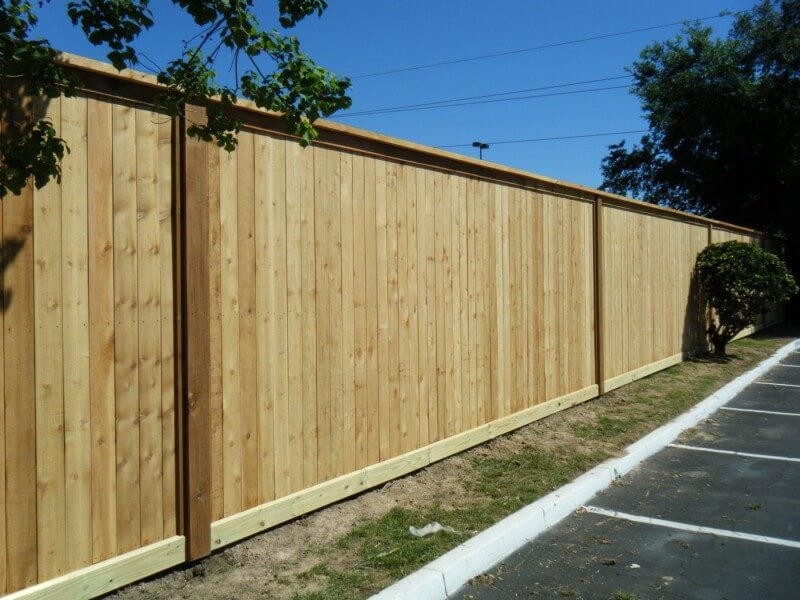Enhance Your Business with Commercial Wood Fences: Best Benefits
Are you keen on ramping up your business security without compromising aesthetic appeal? Discover the perfect blend of robust protection and elegant design with commercial wood fences. As both a deterrent to unwelcome guests and a decorative feature, the proper fence can be a crucial component of your business strategy. Dive into our comprehensive guide on professional-grade wood fencing installation and its impressive perks for your Texas-based enterprise. Let’s explore how these wooden guardians can boost your business’ modern security needs while enhancing your property’s architectural charm naturally.
Commercial wood fences offer many benefits, including privacy, noise reduction, enhanced security, and aesthetic appeal. They can be customized to fit your specific needs and budget, making them a versatile option for businesses of all sizes. Furthermore, they are durable and low-maintenance when properly installed and maintained by a professional fencing company like ours.

Types of Commercial Wood Fences
When it comes to enhancing your business security, commercial wood fences offer a timeless and classic solution. Not only do they provide a strong physical barrier, but they also add a touch of elegance to your property. Let’s explore the different types of commercial wood fences that you can consider for your business.
1. Privacy Wood Fences: If confidentiality and seclusion are priorities for your business, then privacy wood fences are an ideal choice. These fences are typically taller in height, designed to obstruct the view from outside and create a private space within your property. They provide excellent security and serve as an effective deterrent for potential intruders.
Imagine you own a high-profile law firm or a restaurant with outdoor seating. By installing privacy wood fences around the premises, you create a secure environment for clients or customers to feel protected while maintaining their privacy.
2. Picket Wood Fences: Picket wood fences are widely recognized for their charming appearance and ability to add curb appeal to commercial properties. These fences consist of evenly spaced vertical wooden boards attached to horizontal rails. They offer a more open design compared to privacy fences while still providing some level of security.
For instance, if you have a boutique clothing store or an art gallery, picket wood fences can delineate your property boundaries without completely obscuring the view. This allows passersby to get a glimpse of what your establishment has to offer, enticing them to step inside.
3. Ranch Rail Wood Fences: Ranch rail wood fences, also known as split-rail fences, are popular in rural or countryside areas. These fences feature horizontal rails securely fastened between sturdy wooden posts, creating a timeless and rustic charm. While they may not provide high levels of security due to their open design, they can effectively demarcate large areas and serve decorative purposes.
If your business is located on expansive land, such as a vineyard or an equestrian center, ranch rail wood fences can establish boundaries while preserving the natural aesthetic of the surrounding environment. They can also enhance the overall appeal of your property, leaving a lasting impression on visitors.
Options in Natural Wood Fences
Natural wood fences are versatile and offer a wide range of aesthetic possibilities for commercial properties. The choice of wood species and finishes can significantly impact the overall look and durability of your fence. Here are some options to consider when it comes to natural wood fences:
1. Cedar Wood: Cedar is a popular choice for natural wood fences due to its inherent resistance to decay, insects, and rot. This makes it highly durable and long-lasting. Additionally, cedar wood has a distinct grain pattern and warm reddish-brown hue, adding a touch of elegance to any commercial property.
For example, if you own a boutique hotel with a garden area or an upscale spa, a cedar commercial wood fence can beautifully blend with the surrounding landscape, creating a serene and inviting atmosphere for guests.
2. Redwood: Redwood is another sought-after option for natural wood fences due to its natural resistance to rotting and decay. It boasts rich reddish-brown tones and fine-grained patterns that exude sophistication and visual appeal.
Suppose you operate a high-end restaurant with outdoor dining spaces or an exclusive golf club. In that case, redwood fences can elevate the overall ambiance by seamlessly blending with nature while providing privacy and security to patrons within these areas.
3. Pine Wood: Pine is a more affordable alternative compared to cedar or redwood but still offers durability and strength. It can be customized with various stains or finishes to achieve the desired look, making it a versatile option for commercial property owners.
Imagine you own a recreational facility or community center. Pine wood fences, when stained to match your branding or aesthetic preferences, can create a cohesive and welcoming environment for visitors while maintaining security.
Overview of Wood Panels and Posts
Wood panels and posts are the fundamental components of a commercial wood fence. These elements play a crucial role in providing security, privacy, and aesthetics to your business property.
When it comes to wood panels, they are typically constructed using high-quality lumber, such as cedar or pine. These panels are available in various styles, including picket, board-on-board, stockade, and more. Each style offers its own unique look and level of privacy. The thickness of the panel boards can also vary, affecting both the durability and overall appearance of the fence.
For instance, a board-on-board style creates an elegant yet secure fence by incorporating overlapping vertical boards on both sides of horizontal supports. This design offers excellent privacy while maintaining an attractive look.
The other essential component is the wood posts that provide support and stability to the entire fence structure. Typically made from treated lumber for added strength and resistance to weathering, these posts can be either round or square in shape.
It’s important to select the right size and type of posts to ensure proper installation. For example, heavier or taller fences may require thicker or deeper-set posts to withstand wind loads and maintain stability over time.
Proper maintenance is crucial to extend the lifespan and durability of wood panels and posts. Regular painting or staining helps protect against moisture damage, rotting, and insect infestation. Additionally, periodic inspections should be conducted to identify any signs of wear or damage that might compromise the integrity of the fence.
Overall, understanding the different styles and qualities of wood panels and posts is essential when considering a commercial wood fence installation. This knowledge will enable you to choose the best options that align with your business needs while ensuring long-lasting performance.
Why Choose a Commercial Wood Fence?
When it comes to enhancing your business security, commercial wood fences offer numerous advantages that make it a popular choice among business owners. Let’s explore the key reasons why you should consider a commercial wood fence for your property.
Security:
A well-constructed and properly installed wood fence acts as a physical barrier, deterring unauthorized access and protecting your business premises. The height and design of the fence can be customized according to your security requirements.
Privacy:
In certain industries or businesses, privacy is of utmost importance. A solid wood fence provides an excellent solution, creating a secluded and secure environment that prevents prying eyes and reduces noise transfer.
Aesthetics:
Commercial wood fences are known for their natural beauty and versatility. They effortlessly blend with various architectural styles, enhancing the overall curb appeal of your business property. Wood fences can be stained or painted in different colors to match your branding or complement existing structures.
Cost-effectiveness:
Compared to other fencing materials like wrought iron or brick, commercial wood fences tend to be more affordable upfront without compromising on quality or durability. Additionally, they can be easily repaired and modified when needed, which helps reduce long-term maintenance costs.
Sustainability:
Wood is a renewable and environmentally friendly material when sourced from responsibly managed forests. Choosing commercial wood fences demonstrate your commitment to sustainability and eco-conscious practices.
By considering these compelling reasons, you can make an informed decision about whether a commercial wood fence is the right choice for enhancing the security and aesthetics of your business property.
Combining Safety with Aesthetics
When it comes to enhancing the security of your business premises, commercial wood fences offer an excellent combination of safety and aesthetics. Wood fences provide a warm and inviting appearance that can enhance the overall appeal of your property, while also providing a strong barrier against unauthorized access. These fences are available in various styles, such as picket fences, privacy fences, or board-on-board designs, allowing you to choose one that complements your business’s architectural style and meets your security needs.
One key advantage of commercial wood fences is their versatility. They can be customized to different heights and designs, ensuring that you find a fence that fits the unique layout of your business property. Whether you need a low picket fence for aesthetic purposes or a tall privacy fence for maximum security, wood fences can be tailored to suit your specific requirements.
But how do wood fences enhance safety? Well, they act as physical barriers that restrict unauthorized entry into your business property. Their sturdy construction and solid panels make it difficult for intruders to breach them easily. Additionally, wood fences can be combined with lockable gates and other security features to deter potential trespassers further.
For instance, imagine you run a boutique store where showcasing your merchandise is important. By installing a wooden picket fence around the front area of your store, you can create an inviting and secure environment for potential customers. This fence not only adds charm but also prevents unwanted foot traffic from entering directly into the display area.
It’s essential to strike a balance between security and aesthetics when choosing a fence for your commercial property. Having an attractive exterior can attract customers and positively impact your brand image. At the same time, ensuring the safety of your employees, assets, and data is paramount.
Balancing Costs and Durability
One important aspect to consider when installing a commercial wood fence is striking the right balance between costs and durability. Wood fences are known for their affordability compared to other fencing materials, making them a popular choice for many businesses. However, choosing a fence solely based on its initial cost might lead to unforeseen expenses in the long run.
It’s crucial to carefully assess the durability of the wood material used and the overall construction quality of the fence. High-quality materials, such as cedar or redwood, offer natural resistance to decay, rotting, and insect infestation, which can significantly extend the lifespan of your fence. Investing in these durable wood materials upfront can save you money on repairs and replacements down the line.
Proper maintenance is also essential for ensuring the longevity of your commercial wood fence. Regular inspections, cleaning, and applying protective sealants or stains are recommended to prevent moisture damage and maintain the structural integrity of the wood.
Another consideration is understanding that different styles of wood fences may require varying levels of maintenance. For example, while a picket fence may need more frequent touch-ups due to exposure to weather elements, a privacy fence with overlapping boards might require less maintenance in comparison.
Let’s say you own a restaurant with an outdoor patio area where customers enjoy their meals. A commercial wooden privacy fence surrounding this space not only provides security but creates an intimate and comforting atmosphere for your patrons. By selecting a durable wood type and properly maintaining it over time, you ensure that your investment remains intact while enhancing both aesthetic appeal and safety.
Pre-purchase Factors for Commercial Wood Fences
When considering the installation of a commercial wood fence, there are several pre-purchase factors to consider. These factors will help ensure that you make an informed decision and choose a fence that meets your business’s specific needs.
First and foremost, it’s crucial to assess the intended purpose of the fence. Are you prioritizing security, privacy, or aesthetics? Determining your primary objective will guide your decision-making process and allow you to select a fence design that aligns with your goals.
A business operating in a high-crime area may prioritize security by opting for a taller, solid wood fence design with added features like anti-climbing measures and secure gate access. On the other hand, a business in a less vulnerable location may place more emphasis on aesthetics and choose a fence design that complements the overall look and feel of their establishment.
The next factor to consider is the local climate and weather conditions. Wood fences are durable but can be vulnerable to certain weather elements if not properly maintained. Assessing the exposure to sunlight, rain, wind, and potential moisture levels will help determine whether you need to opt for certain wood species or apply protective treatments such as sealants or stains.
It’s also important to evaluate the required level of maintenance for the chosen wood fence. Different wood species have varying maintenance requirements, so consider how much time and effort your business can allocate to regular upkeep. Discuss options with your fencing contractor, as they can provide valuable insights into low-maintenance wood species and provide recommendations based on your specific needs.
For instance, if your business is in an area prone to termites or other pests that can damage wood, it might be wise to choose a naturally resistant wood species or explore alternative fencing materials that require less maintenance.
Additionally, before finalizing your purchase decision, it’s crucial to consider any local zoning regulations, building codes, or special permits required for installing commercial wood fences. Ensure compliance with all legal requirements by conducting thorough research or consulting with local authorities. This will help avoid any potential issues and ensure a smooth and hassle-free installation process.
Style Considerations for Businesses
The style of your commercial wood fences can make a significant difference in enhancing the overall aesthetic appeal and professionalism of your business premises. When choosing a fence design, it’s important to align it with your brand image, architectural style, and the nature of your business.
Consider whether you want your fencing to blend in seamlessly with the surroundings or act as a standout feature. Aesthetically pleasing wood fence designs, such as horizontal slat styles or decorative lattice patterns, can create an inviting and sophisticated look that impresses customers and clients alike.
On the other hand, some businesses may opt for more traditional picket-style fences to evoke a sense of warmth and nostalgia, particularly in industries like hospitality or childcare where a friendly and welcoming ambiance is desired.
It’s also essential to consider how the chosen fence design complements the existing landscape and architectural features of your business property. A well-designed fence should seamlessly integrate into the overall aesthetic without appearing disjointed or out of place.
A business set amidst lush green gardens might benefit from a natural wood fence that harmonizes with the surrounding foliage, creating a balanced and visually appealing environment.
Another key consideration is branding. If your business has specific colors or logos associated with its brand identity, incorporating these elements into the fence design can reinforce brand recognition and enhance marketing opportunities. Customizing your wood fence with signage or incorporating painted panels in company colors can provide a unique touch that sets your business apart from competitors.
Considering these style considerations will not only enhance the overall appearance of your business but also contribute to its professional image and credibility. By reflecting your brand identity and seamlessly integrating with the design of your property, a well-chosen wood fence can leave a lasting impression on clients, customers, and visitors.
Examining Durability and Maintenance Needs
When considering options for enhancing your business security, it’s crucial to examine the durability and maintenance needs of different fencing materials. In this regard, commercial wood fences offer unique advantages that make them a popular choice for many businesses.
Wood fences provide a natural and timeless aesthetic that can enhance the overall appearance of your business premises. They have a warm and inviting appeal that can create a welcoming atmosphere for customers and clients. Additionally, commercial wood fences can be customized to suit your specific design preferences, allowing you to maintain the visual identity of your business.
However, one concern that often arises when it comes to wood fences is their durability and maintenance requirements. It’s true that wood is susceptible to weathering, rotting, and insect damage if not properly maintained. This means that regular upkeep is essential to ensure the longevity of your wood fence.
To address these concerns, modern wood fencing options are now treated with preservatives and sealants to increase their durability and resistance against environmental factors. These treatments help protect the wood from moisture damage, fungal growth, and insect infestations.
Regular maintenance tasks for wood fences may include cleaning the surface with mild detergent or bleach solution to remove dirt and stains. Periodically inspecting the fence for any signs of damage such as loose boards or splintering is also important. If any issues are identified, prompt repairs should be carried out to prevent further deterioration.
| Material | Durability | Maintenance |
| Wood Fences | Susceptible to weathering and rotting without proper maintenance | Regular cleaning, inspections, and repairs required |
| Iron and Aluminum Fences | Durable and resistant to environmental factors | Minimal maintenance required, occasional cleaning and touch-ups |
| Vinyl Fences | Durable and highly resistant to weathering and rotting | Low maintenance, occasional cleaning with soap and water |
It’s important to note that while wood fences do require regular maintenance, they can still provide a durable and long-lasting solution if properly cared for. The natural beauty they bring to your business premises may outweigh the necessary maintenance efforts. Additionally, with periodic staining or painting, you can further enhance the durability and extend the lifespan of your wood fence.
Understanding the maintenance needs and longevity of wood fences is essential when considering them as a security enhancement for your business.
Maintenance and Longevity of Wood Fences
Maintaining a wood fence is crucial to ensure its longevity and continued effectiveness in providing security for your business. Regular upkeep helps prevent issues such as rot, deterioration, or structural instability.
To maintain the integrity of your wood fence, here are some key steps to consider:
- Cleaning: Regularly clean the surface of the fence using a mild detergent or bleach solution. This will remove dirt, grime, and any organic matter that could lead to decay or discoloration. Rinse thoroughly with water afterward.
- Inspecting: Conduct routine inspections of your wood fence to identify any signs of damage or wear. Look for loose boards, cracks, or splinters that need immediate attention. Prompt repairs can prevent further damage and ensure the longevity of your fence.
- Sealing or Staining: Applying a protective sealant or stain is another important step in maintaining a wood fence. This helps protect the wood from moisture, UV rays, and other environmental factors that can lead to decay. Sealants should be reapplied every few years based on the manufacturer’s recommendations.
- Trimming Vegetation: Trim or remove any vegetation near your wood fence that could promote moisture retention or damage the structure. Overgrown plants can create a humid environment, leading to rot and insect infestations.
- Addressing Structural Issues: If you notice any significant structural issues with your wood fence, such as leaning posts or sagging sections, it’s essential to address these problems promptly. Seeking professional help for repairs ensures that your fence remains sturdy and secure.
A well-maintained wood fence can last for decades, providing security while maintaining an aesthetic appeal for your business premises. The investment in regular maintenance ensures that your wood fence retains its functionality and enhances the overall security of your business.
Steps in Professional Fence Installation
When it comes to ensuring the security and privacy of your business premises, a commercial wood fence can be a great solution. However, installing a fence professionally requires careful planning and execution. Let’s walk through the steps involved in professional fence installation.
1. Site Evaluation: The first step is to evaluate the site where the fence will be installed. This involves assessing the terrain, measuring the dimensions of the area, and identifying any potential obstacles or challenges that may impact the installation process. It’s essential to consider factors such as underground utilities, property lines, and any local regulations or permits required.
For instance, imagine you’re a restaurant owner looking to install a wood fence around your outdoor dining space. Before proceeding with the installation, you would need to determine if there are any underground pipes or cables that may interfere with the fence’s placement.
2. Material Selection: Once the site has been evaluated, it’s time to choose the appropriate materials for your commercial wood fence. Consider factors such as durability, maintenance requirements, and aesthetics when making your selection. Wood fences offer a natural and timeless look while providing security and privacy for your business.
Continuing with our restaurant example, you might opt for cedar wood for its natural resistance to decay and insects, as well as its appealing appearance that complements your outdoor seating area.
3. Design and Planning: After selecting the materials, it’s crucial to design and plan your fence layout carefully. Consider elements such as height, gate locations, and any additional features like decorative accents or security measures. Working closely with a professional fence contractor can help ensure that your design meets all necessary specifications.
In our restaurant scenario, you may decide on a taller wooden fence to provide both privacy from passersby and noise reduction from nearby traffic. Additionally, strategically placed gates can provide convenient access for staff and customers.
4. Permits and Regulations: Before proceeding with the installation, it’s essential to obtain any necessary permits and ensure compliance with local regulations. This may involve submitting plans to the appropriate authorities, providing documentation, or obtaining variances in special cases. Adhering to these requirements helps avoid potential legal issues in the future.
Returning to our restaurant example, you would need to consult with local zoning departments to determine any height restrictions or setback requirements for installing a fence in an outdoor dining area.
5. Installation: With all the necessary preparations complete, it’s time to begin the installation process. Professional fence contractors have the expertise and equipment needed to efficiently install your commercial wood fence. They will start by marking out the fence line, digging post holes, setting posts securely in place, and attaching the horizontal rails and pickets. The professionals ensure proper alignment, stability, and a visually appealing finished product.
The skilled fence installers you hire for your restaurant would carefully handle each stage of the installation process, taking precautions to prevent damage or disruption to your business operations.
6. Finishing Touches: Once the fence is installed, attention can be given to adding finishing touches. This may include staining or painting the wood for added protection against weather elements and enhancing its aesthetic appeal. Optional features like locks for gates or decorative accents can also be added according to your specific needs and preferences.
In our restaurant scenario, you might choose to stain the wooden fence with a color that complements your outdoor seating area’s overall design theme, creating a cohesive look for your business.
By following these steps and working with professional fence installers experienced in commercial wood fences, you can enhance your business security while maintaining an attractive appearance for your premises.








